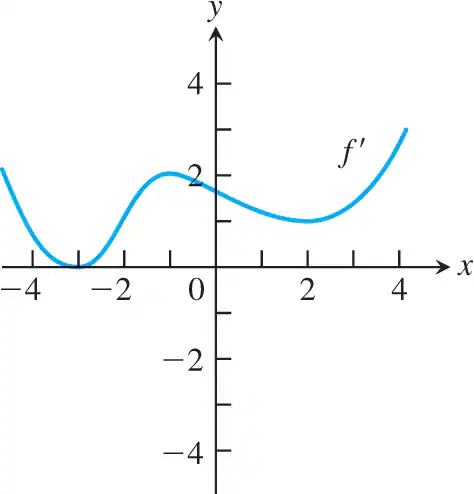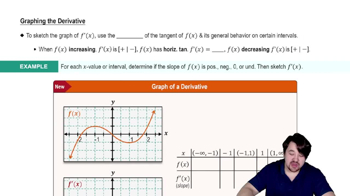Each of Exercises 89–92 shows the graphs of the first and second derivatives of a function y=f(x). Copy the picture and add to it a sketch of the approximate graph of f, given that the graph passes through the point P.
Table of contents
- 0. Functions7h 54m
- Introduction to Functions16m
- Piecewise Functions10m
- Properties of Functions9m
- Common Functions1h 8m
- Transformations5m
- Combining Functions27m
- Exponent rules32m
- Exponential Functions28m
- Logarithmic Functions24m
- Properties of Logarithms36m
- Exponential & Logarithmic Equations35m
- Introduction to Trigonometric Functions38m
- Graphs of Trigonometric Functions44m
- Trigonometric Identities47m
- Inverse Trigonometric Functions48m
- 1. Limits and Continuity2h 2m
- 2. Intro to Derivatives1h 33m
- 3. Techniques of Differentiation3h 18m
- 4. Applications of Derivatives2h 38m
- 5. Graphical Applications of Derivatives6h 2m
- 6. Derivatives of Inverse, Exponential, & Logarithmic Functions2h 37m
- 7. Antiderivatives & Indefinite Integrals1h 26m
- 8. Definite Integrals4h 44m
- 9. Graphical Applications of Integrals2h 27m
- 10. Physics Applications of Integrals 3h 16m
- 11. Integrals of Inverse, Exponential, & Logarithmic Functions2h 31m
- 12. Techniques of Integration7h 41m
- 13. Intro to Differential Equations2h 55m
- 14. Sequences & Series5h 36m
- 15. Power Series2h 19m
- 16. Parametric Equations & Polar Coordinates7h 58m
5. Graphical Applications of Derivatives
Concavity
Problem 4.4.99
Textbook Question
99. In Exercises 99 and 100, the graph of f' is given. Determine x-values corresponding to inflection points for the graph of f.

 Verified step by step guidance
Verified step by step guidance1
Step 1: Recall that inflection points occur where the second derivative of a function changes sign. This means we need to analyze the graph of f' to determine where the slope of f' (which represents f'') changes from positive to negative or vice versa.
Step 2: Observe the graph of f'. The slope of f' changes sign at points where the graph of f' transitions from increasing to decreasing or decreasing to increasing. These are the x-values where the graph of f' has local maxima or minima.
Step 3: Identify the x-values of local maxima and minima on the graph of f'. From the graph, it appears that there are local maxima at x ≈ -2 and local minima at x ≈ 2.
Step 4: Verify that these points correspond to changes in the sign of the slope of f'. At x ≈ -2, the slope of f' changes from positive to negative, and at x ≈ 2, the slope of f' changes from negative to positive.
Step 5: Conclude that the x-values corresponding to inflection points for the graph of f are approximately x = -2 and x = 2.
 Verified video answer for a similar problem:
Verified video answer for a similar problem:This video solution was recommended by our tutors as helpful for the problem above
Video duration:
2mPlay a video:
Was this helpful?
Key Concepts
Here are the essential concepts you must grasp in order to answer the question correctly.
Derivative and Its Graph
The derivative of a function, denoted as f', represents the rate of change of the function f. The graph of f' provides insights into the behavior of f, such as where it is increasing or decreasing. Points where f' changes from positive to negative indicate local maxima, while points where it changes from negative to positive indicate local minima.
Recommended video:

Graphing The Derivative
Inflection Points
Inflection points occur where the concavity of a function changes, which can be identified by analyzing the second derivative, f''. However, when given the graph of f', inflection points correspond to where f' changes its increasing or decreasing behavior. This means that the x-values where f' has local extrema (maxima or minima) are potential inflection points for f.
Recommended video:

Critical Points
Critical Points
Critical points are values of x where the derivative f' is either zero or undefined. These points are significant because they can indicate local maxima, minima, or inflection points. In the context of the given graph, identifying the x-values where f' equals zero helps in determining where the function f may have changes in concavity, leading to inflection points.
Recommended video:

Critical Points

 6:38m
6:38mWatch next
Master Determining Concavity from the Graph of f with a bite sized video explanation from Patrick
Start learningRelated Videos
Related Practice
Textbook Question
